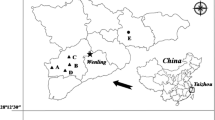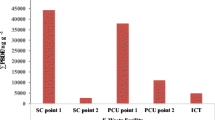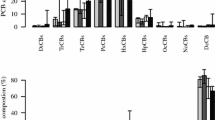Abstract
Various hazardous substances contained in waste TV sets might be released into environment via dust during recycling activities. Two brominated flame retardants (BFRs), polybrominated diphenyl ethers (PBDEs), and tetrabromobisphenol A (TBBPA), and five kinds of heavy metals (Cu, Pb, Cd, Cr, and Ni) were detected in indoor dust collected from two workshops (TV dismantling workshop and subsequent recycling workshop). PBDEs concentrations in dust from waste wires recycling line (722,000 ng/g) were the highest among the studied sites, followed by those in manual dismantling–sorting line (117,000 ng/g), whereas TBBPA concentrations were the highest in manual dismantling–sorting line (557 ng/g) and printed circuit board (PCB) recycling line (428 ng/g). For heavy metals, Cu and Pb were the most enriched metals in all dust samples. The highest concentration of Pb (22,900 mg/kg) was found in TV dismantling workshop-floor dust. Meanwhile, Cu was the predominant metal in dust from the PCB recycling line, especially in dust collected from electrostatic separation area (42,700 mg/kg). Occupational exposure assessment results showed that workers were the most exposed to BDE-209 among the four PBDE congeners (BDE-47, BDE-99, BDE-153, and BDE-209) in both workshops. The hazard quotient (HQ) indicated that noncancerous effects were unlikely for both BFRs and heavy metals (HQ < 1), and carcinogenic risks for Cd, Cr, and Ni (risk < 10−6) on workers in two workshops were relatively low.



Similar content being viewed by others
References
Abdallah MA, Harrad S, Covaci A (2008) Hexabromocyclododecanes and tetrabromobisphenol-A in indoor air and dust in Birmingham, UK: implications for human exposure. Environ Sci Technol 42:6855–6861
Alaee M (2003) An overview of commercially used brominated flame retardants, their applications, their use patterns in different countries/regions and possible modes of release. Environ Int 29:683–689
Barba-Gutiérrez Y, Adenso-Díaz B, Hopp M (2008) An analysis of some environmental consequences of European electrical and electronic waste regulation. Resour Conserv Recycl 52:481–495
Bi X, Thomas GO, Jones KC, Qu W, Sheng G, Martin FL, Fu J (2007) Exposure of electronics dismantling workers to polybrominated diphenyl ethers, polychlorinated biphenyls, and organochlorine pesticides in South China. Environ Sci Technol 41:5647–5653
Bi X, Simoneit BRT, Wang Z, Wang X, Sheng G, Fu J (2010) The major components of particles emitted during recycling of waste printed circuit boards in a typical e-waste workshop of South China. Atmos Environ 44:4440–4445
Boyce CP, Sonja N, Dodge DG, Pollock MC, Goodman JE (2009) Human exposure to decabromodiphenyl ether, tetrabromobisphenol A, and decabromodiphenyl ethane in indoor dust. JEPS 3:75–96
Brigden K, Labunska I, Santillo D, Allsopp M (2005) Recycling of electronic wastes in China and India: workplace and environmental contamination. Greenpeace International 55
Chancerel P, Meskers CEM, Hagelüken C, Rotter VS (2009) Assessment of precious metal flows during preprocessing of waste electrical and electronic equipment. J Ind Ecol 13:791–810
Chandrappa R, Das DB (2012) Waste from electrical and electronic equipment. Solid Waste Manage: 197–216
Chang J, Liu M, Li X, Wang L, Gao L (2009) Primary research on health risk assessment of heavy metals in road dust of Shanghai. China Environ Sci 29:548–554
Deng W, Louie P, Liu W, Bi X, Fu J, Wong M (2006) Atmospheric levels and cytotoxicity of PAHs and heavy metals in TSP and PM2.5 at an electronic waste recycling site in southeast China. Atmos Environ 40:6945–6955
Duan H, Li J, Liu Y, Yamazaki N, Jiang W (2012) Characterizing the emission of chlorinated/brominated dibenzo-p-dioxins and furans from low-temperature thermal processing of waste printed circuit board. Environ Pollut 161:185–191
Ebert J, Bahadir M (2003) Formation of PBDD/F from flame-retarded plastic materials under thermal stress. Environ Int 29:711–716
ESPA (2013) Lead stabilisers http://www.stabilisers.org/stabilisers-types/lead-stabilisers
EU (2003) Directive 2002/95/EC of the European Parliament and of the Council on the restriction of the use of certain hazardous substances in electrical and electronic equipment. Off J Eur Union 46:L37/19–23
Fang W, Yang Y, Xu Z (2013) PM and PM and health risk assessment for heavy metals in a typical factory for cathode ray tube television recycling. Environ Sci Technol 47:12469–12476
Hites RA (2004) Polybrominated diphenyl ethers in the environment and in people: a meta-analysis of concentrations. Environ Sci Technol 38:945–956
Huang K, Guo J, Xu Z (2009) Recycling of waste printed circuit boards: a review of current technologies and treatment status in China. J Hazard Mater 164:399–408
Huismann J, Magalini F, Kuehr R, Maurer C, Ogilvoe S, Poll J, Delgado C, Artim E, Szlezak J, Stevels A (2008) Review of directive 2002/96 on waste electrical and electronic equipment (WEEE). UNU, Bonn
Johnson-Restrepo B, Kannan K (2009) An assessment of sources and pathways of human exposure to polybrominated diphenyl ethers in the United States. Chemosphere 76:542–548
Kajiwara N, Noma Y, Takigami H (2008) Photolysis studies of technical decabromodiphenyl ether (DecaBDE) and ethane (DeBDethane) in plastics under natural sunlight. Environ Sci Technol 42:4404–4409
Kemmlein S, Hahn O, Jann O (2003) Emissions of organophosphate and brominated flame retardants from selected consumer products and building materials. Atmos Environ 37:5485–5493
La Guardia MJ, Hale RC, Harvey E (2006) Detailed polybrominated diphenyl ether (PBDE) congener composition of the widely used penta-, octa-, and deca-PBDE technical flame-retardant mixtures. Environ Sci Technol 40:6247–6254
Lee C, Hsi C (2002) Recycling of scrap cathode ray tubes. Environ Sci Technol 36:69–75
Leung AO, Duzgoren-Aydin NS, Cheung K, Wong MH (2008a) Heavy metals concentrations of surface dust from e-waste recycling and its human health implications in southeast China. Environ Sci Technol 42:2674–2680
Leung AO, Zheng JS, Wong MH (2008b) PBDEs in dust from printed circuit board recycling at an e-waste hotspot in southeastern China. Organohalogen Compd 70:174
Leung AO, Zheng J, Yu CK, Liu WK, Wong CK, Cai Z, Wong MH (2011) Polybrominated diphenyl ethers and polychlorinated dibenzo-p-dioxins and dibenzofurans in surface dust at an E-waste processing site in Southeast China. Environ Sci Technol 45:5775–5782
Ma J, Addink R, Yun S, Cheng J, Wang W, Kannan K (2009) Polybrominated dibenzo-p-dioxins/dibenzofurans and polybrominated diphenyl ethers in soil, vegetation, workshop-floor dust, and electronic shredder residue from an electronic waste recycling facility and in soils from a chemical industrial complex in eastern China. Environ Sci Technol 43:7350–7356
Matsuto T, Jung C, Tanaka N (2004) Material and heavy metal balance in a recycling facility for home electrical appliances. Waste manag 24:425–436
Morf LS, Tremp J, Gloor R, Huber Y, Stengele M, Zennegg M (2005) Brominated flame retardants in waste electrical and electronic equipment: substance flows in a recycling plant. Environ Sci Technol 39:8691–8699
Nnorom I, Osibanjo O, Ogwuegbu M (2011) Global disposal strategies for waste cathode ray tubes. Resour Conserv Recycl 55:275–290
Peters-Michaud N, Katers J, Barry J (2003) Occupational risks associated with electronics demanufacturing and CRT glass processing operations and the impact of mitigation activities on employee safety and health. Electronics and the Environment, 2003. IEEE International Symposium on: 323–328
Sakai S, Watanabe J, Honda Y, Takatsuki H, Aoki I, Futamatsu M, Shiozaki K (2001) Combustion of brominated flame retardants and behavior of its byproducts. Chemosphere 42:519–531
Schlummer M, Gruber L, Mäurer A, Wolz G, van Eldik R (2007) Characterisation of polymer fractions from waste electrical and electronic equipment (WEEE) and implications for waste management. Chemosphere 67:1866–1876
Secretariat Stockholm Convention (2012) Guidance on best available techniques and best environmental practice for the recycling and disposal of articles containing polybrominated diphenyl ethers (PBDEs) under the Stockholm Convention on Persistent Organic Pollutants (Draft).
SEPA (1995) Environmental Quality Standards for Soils (GB 15618–1995).
Sepúlveda A, Schluep M, Renaud FG, Streicher M, Kuehr R, Hagelüken C, Gerecke AC (2010) A review of the environmental fate and effects of hazardous substances released from electrical and electronic equipments during recycling: Examples from China and India. Environ Impact Assess Rev 30:28–41
Shaw SD, Blum A, Weber R, Kannan K, Rich D, Lucas D, Koshland CP, Dobraca D, Hanson S, Birnbaum LS (2010) Halogenated flame retardants: do the fire safety benefits justify the risks? Rev Environ Health 25:261–306
Sjödin A, Päpke O, McGahee III E, Jones R, Focant J, Pless-Mulloli T, Toms L, Wang R, Zhang Y, Needham L (2004) Concentration of polybrominated diphenyl ethers (PBDEs) in house hold dust from various countries-inhalation a potential route of human exposure, Dioxin 2004. TU Berlin Servicegesellschaft mbH, pp. 3817–3822
Song Q, Wang Z, Li J, Zeng X (2012) Life cycle assessment of TV sets in China: a case study of the impacts of CRT monitors. Waste Manag 32:1926–1936
Suzuki G, Kida A, S-i S, Takigami H (2009) Existence state of bromine as an indicator of the source of brominated flame retardants in indoor dust. Environ Sci Technol 43:1437–1442
Suzuki G, Someya M, Takahashi S, Tanabe S, S-i S, Takigami H (2010) Dioxin-like activity in Japanese indoor dusts evaluated by means of in vitro bioassay and instrumental analysis: brominated dibenzofurans are an important contributor. Environ Sci Technol 44:8330–8336
Swedish EPA (2011) Recycling and disposal of electronic waste. Health hazards and environmental impacts. Report 6417 of the Swedish Environmental Protection Agency. March 2011
Takigami H, Suzuki G, Hirai Y, Sakai S (2008) Transfer of brominated flame retardants from components into dust inside television cabinets. Chemosphere 73:161–169
Tan J, Cheng SM, Loganath A, Chong YS, Obbard JP (2007) Polybrominated diphenyl ethers in house dust in Singapore. Chemosphere 66:985–992
Tsydenova O, Bengtsson M (2011) Chemical hazards associated with treatment of waste electrical and electronic equipment. Waste Manag 31:45–58
UNEP (2007) Draft risk management evaluation for commercial pentabromodiphenyl ether.
USEPA (1992) Guidelines for Exposure Assessment. In: Agency USEP (Hrsg.). Risk Assessment Forum, Washington, DC
USEPA (2004) Risk Assessment Guidance for Superfund. Volume I: Human Health Evaluation Manual (Part E, Supplemental Guidance for Dermal Risk Assessment). EPA/540/R/99
USEPA (2011) Exposure factors handbook. In: Agency USEP (Hrsg.). Office of Research and Development, Washington, DC
van den Berg M, Denison MS, Birnbaum LS, Devito MJ, Fiedler H, Falandysz J, Rose M, Schrenk D, Safe S, Tohyama C, Tritscher A, Tysklind M, Peterson RE (2013) Polybrominated dibenzo-p-dioxins, dibenzofurans, and biphenyls: inclusion in the toxicity equivalency factor concept for dioxin-like compounds. Toxicological sciences: an official journal of the Society of Toxicology 133:197–208
Wager PA, Schluep M, Muller E, Gloor R (2012) RoHS regulated substances in mixed plastics from waste electrical and electronic equipment. Environ Sci Technol 46:628–635
Wang D, Cai Z, Jiang G, Leung A, Wong MH, Wong WK (2005) Determination of polybrominated diphenyl ethers in soil and sediment from an electronic waste recycling facility. Chemosphere 60:810–816
Wang Z, Liu S, Chen X, LIN C (2008) Estimates of the exposed dermal surface area of Chinese in view of human health risk assessment. Journal of Safety and Environment 4:038
Wen S, Yang F, Gong Y, Zhang X, Hui Y, Li J, Liu A, Wu Y, Lu W, Xu Y (2008) Elevated levels of urinary 8-hydroxy-2′-deoxyguanosine in male electrical and electronic equipment dismantling workers exposed to high concentrations of polychlorinated dibenzo-p-dioxins and dibenzofurans, polybrominated diphenyl ethers, and polychlorinated biphenyls. Environ Sci Technol 42:4202–4207
Xue M, Yang Y, Ruan J, Xu Z (2012) Assessment of noise and heavy metals (Cr, Cu, Cd, Pb) in the ambience of the production line for recycling waste printed circuit boards. Environ Sci Technol 46:494–499
Yuan W, Li J, Zhang Q, Saito F (2012) Innovated application of mechanical activation to separate lead from scrap cathode ray tube funnel glass. Environ Sci Technol 46:4109–4114
Zhang BZ, Zhang K, Li SM, Wong CS, Zeng EY (2012) Size-dependent dry deposition of airborne polybrominated diphenyl ethers in urban Guangzhou. China Environ Sci Technol 46:7207–7214
Zhou X, Guo J, Lin K, Huang K, Deng J (2013) Leaching characteristics of heavy metals and brominated flame retardants from waste printed circuit boards. J Hazard Mater 246–247:96–102
Acknowledgments
This work was financially supported by the National Environmental Protection Public Welfare Science and Technology Research Program of China (201309047), the National Natural Science Foundation of China (40901148, 21307030), Fundamental Research Funds for the Central Universities (WB1114060), and China Postdoctoral Science Special Foundation (2012T50402). We also appreciate the anonymous referees for their helpful comments on this paper.
Author information
Authors and Affiliations
Corresponding author
Additional information
Responsible editor: Gerhard Lammel
Electronic supplementary material
Below is the link to the electronic supplementary material.
ESM 1
(DOCX 358 kb)
Rights and permissions
About this article
Cite this article
Deng, J., Guo, J., Zhou, X. et al. Hazardous substances in indoor dust emitted from waste TV recycling facility. Environ Sci Pollut Res 21, 7656–7667 (2014). https://doi.org/10.1007/s11356-014-2662-9
Received:
Accepted:
Published:
Issue Date:
DOI: https://doi.org/10.1007/s11356-014-2662-9




